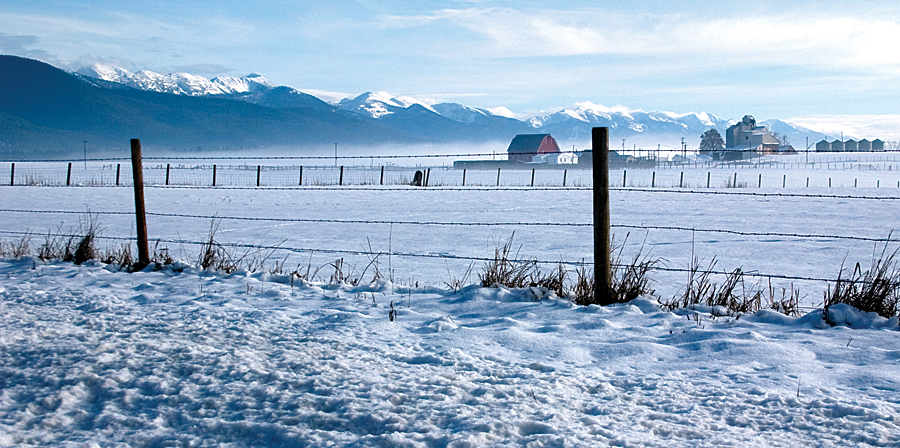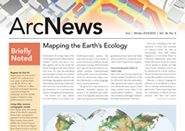A Montana electric cooperative has eliminated yellow notepads and hours of data input in its system surveying procedure.
Sixty miles south of the Canadian border, Montana’s largest electric cooperative serves more than 48,000 members who live in an area of wilderness, ski slopes, and glaciers. Flathead Electric Cooperative manages more than 4,500 miles of overhead and underground power lines.
In 2013, Flathead started a systematic surveying project. At that time, Flathead’s field-workers used yellow notepads for field data collection. Synthesizing these handwritten notes was a manual process that used various software systems and took months.

One of Flathead’s interns collected as many as 100 data points in a day. It took GIS specialist Amanda Opp about seven months to manually input the intern’s data into Flathead’s software systems. Although Flathead had ArcGIS for Desktop, the co-op wasn’t ready to use the Collector for ArcGIS app. This app lets field-workers capture data on a mobile device instead of paper.
At the time, the app required connectivity so the utility didn’t use its ArcGIS Online account. “We live and work in a rural area that oftentimes doesn’t have cell coverage,” Opp said. “And who wants to pay for an expensive data plan anyway?”
An ArcGIS Online update released in 2014 allowed Collector to be used offline—a transformative capability in rural areas without Wi-Fi access or data plans. Suddenly Opp could use ArcGIS Online, and she seized the opportunity.
“The offline release was massive,” said Russ Roberts, an Esri product engineer on the Collector for ArcGIS team. “It took a whole crew of teams working together seamlessly so we could flip the switch one night and get this Collector and ArcGIS Online release out together.”
The switch flipped at Flathead too. “We realized in March with the release of Collector that this was big,” Opp said. “I didn’t realize how big until we started using it.”
Opp spent two months configuring the app for Flathead’s needs. She uploaded layers and maps and defined data that needed to be collected using drop-down menus. She used large, familiar symbols that were legible on a tablet and could be discerned if several of the same asset were in close proximity. Opp created a green triangle for a transformer, an orange star for a distribution pole, and a blue dot for a high-voltage transmission pole. A blue dot set on top of a green triangle on top of an orange star indicates a distribution pole and a transformer in the same spot.
Opp got an iPad from the director of engineering and loaded the app on it. She gave it to Matt Stahlberg, an electrical engineering student who had just started an internship with Flathead.
“The first time I used it was on the first day,” Stahlberg said. He had no prior GIS experience. “I wouldn’t say any of it was challenging,” he said. “Everything was clear-cut with how to interface with it.”
Initially, Collector drained the device battery before the day was over. Saving a data point could take hours. Stahlberg and Opp voiced their concerns on GeoNet, Esri’s social media networking site that helps users collaborate with Esri product engineers.
“I was really impressed with how fast everything was updated,” Stahlberg said. “It took forever to save data points, and someone was right there to fix that. In the next update, the save time goes down to two seconds; battery life doubles. If there was something they needed to change, it was pretty much right away.”
Roberts helped Opp fix an issue with querying map layers. This was a must for a company with 45,000 poles and many other assets. Roberts dug into Flathead’s web maps and saw the issue in the code. He brought the code to the ArcGIS Online team, and they fixed it.
Stahlberg’s data improved the accuracy of Flathead’s survey over the paper-based surveying. “With a system this big, there’s always morphing data and mistakes,” Opp said. “But to get it closer to accurate is always the goal.”
Much of the surveying work was old. Some had been done 20 years ago. The GPS on the iPad was significantly more accurate than those old surveys. “Generally large structures you could see from a distance,” said Stahlberg. “But now we were able to see them down to within a few feet of a point rather than a hundred yards or more.”
Not only was the data more accurate, it was also coming in faster. Opp’s work preparing Collector for Stahlberg let him do twice as much work in a day. Opp said he was moving so fast she couldn’t keep up with him.
One of Opp’s configurations included loading old survey data into the layers Stahlberg could access. One day Stahlberg resolved a discrepancy between the old survey and his GPS observations. The discrepancy was close to 200 feet. Previously he would have written down the information, gone back to the office to check it, and then gone back to verify everything. Instead everything was on the iPad, so he could make the correction in the field.
Opp has become a Collector evangelist. She was an ArcGIS Online novice when she started configuring Collector. “I was a baby,” she said. “I hadn’t even been in GIS a year.” Opp worked as a cashier for 10 years before—with encouragement from friends—she put a civil engineering degree to use at Flathead.
Now, she writes posts for GeoNet and LinkedIn telling people how to build ArcGIS Online maps and collect data while using the minimum number of credits. “I want to encourage other utilities to go boldly in this direction because it is a huge time saver,” she said.
Opp admits being initially perplexed. “Trust me, I hit a wall a time or two.” But she encourages novices to use GeoNet. “There are users on there who have done what you’re doing.”
With Stahlberg back in school, Opp has taken charge of the iPad and is locating and labeling transformers before winter comes. This winter, Flathead hopes to use Collector to survey 1,100 light poles in Kalispell, the county seat of Flathead County. The co-op has shown interest in learning how to use Collector for meter surveys.
“Once it catches fire, it really does,” Opp said. “We’re streamlining our system survey with spatial data and marrying the two in a way where I can bring it into my map all at once.”

